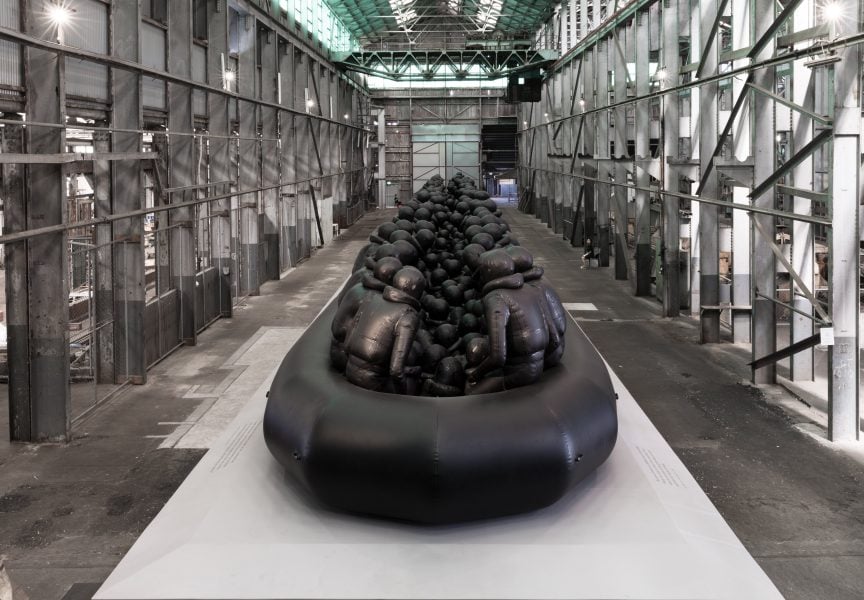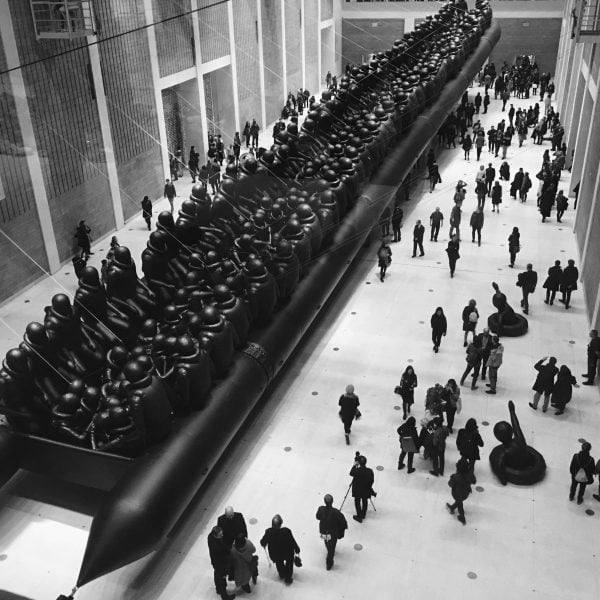Home Participants 21st Biennale of Sydney (2018) Ai Weiwei
Ai Weiwei


Ai Weiwei
Born 1957 in Beijing, China Lives and works in Berlin, Germany

For the 21st Biennale of Sydney, Ai presents a series of interconnected works across multiple locations. In the Industrial Precinct of Cockatoo Island, Ai’s Law of the Journey, 2017, creates an imposing statement. Featuring a 60-metre-long boat crowded with hundreds of anonymous refugee figures, the work brings the monumental scale of the humanitarian crisis sharply into focus. The inflatable boat and figures are made from black rubber and fabricated in a Chinese factory that also manufactures the precarious vessels used by thousands of refugees attempting to cross the Mediterranean Sea.
Accompanying Law of the Journey is a wallpaper featuring photographs taken by Ai on an iPhone while making the documentary film Human Flow, 2017. Also displayed as part of the installation are four video works. Filmed over several days, At Sea, 2016, shows overcrowded, inflatable rafts delivering a constant flow of people to the shores of the Greek Island of Lesvos. In On the Boat, 2016, Ai stands alone on an partially submerged, inflatable vessel discovered floating in the Mediterranean Sea, the fates of its passengers unknown. Floating, 2016, features footage of the same raft, abandoned to the seemingly limitless expanse of the ocean. Ai Weiwei Drifting, 2017, is a documentary film that follows Ai over the course of one year as he created a series of works focused on the refugee crisis.
Exhibited at Artspace, Crystal Ball, 2017, is a sculptural installation that consists of a large glass sphere cradled by a nest of life jackets. Associated with fortune telling and clairvoyance, a crystal ball or orbuculum is thought to show images that predict the future. Ai’s Crystal Ball reveals a world inverted; a chaotic reality in which millions of people have been forced to leave their homes to escape war and conflict, their futures now uncertain.
Ai’s feature-length documentary, Human Flow, 2017, will also be premiered in Sydney as part of the Biennale program. The film chronicles the global refugee crisis through footage and interviews filmed in more than 23 countries including Greece, Afghanistan, Bangladesh, Sweden and Italy. Human Flow articulates the massive scale of migration while focusing on some of the individual experiences of refugees, humanising a crisis of almost incomprehensible scale.
Arguably the most famous Chinese artist living today, much of Ai Weiwei’s work exists in the space between art and activism, often blurring the boundaries between the two. Politically outspoken and an avid user of social media, Ai creates works rich with symbolism and metaphor that draw attention to social injustice. In recent years Ai has focused his practice on advocating for refugees’ human rights, documenting the experiences and conditions faced by millions of people who have been forcibly displaced from their homes. Speaking about the situation, Ai states: ‘There’s no refugee crisis, only a human crisis… In dealing with refugees we’ve lost our very basic values. In this time of uncertainty, we need more tolerance, compassion and trust for each other, since we are all one, otherwise humanity will face an even bigger crisis.’